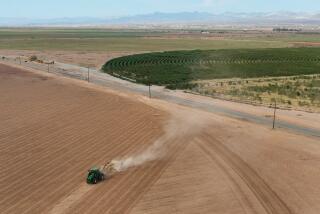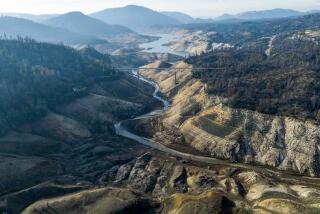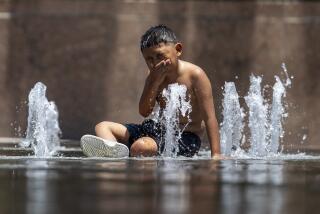Warmer Pacific May Signal New El Nino
NEW YORK â Weather analysts are carefully watching a recent warming of the equatorial Pacific Ocean that they fear indicates the onset of another El Nino, the sometimes catastrophic disturbance of world weather patterns.
Surface temperatures across most of the Pacific from the South American coast to west of the international dateline, a distance spanning one quarter the earthâs diameter, have risen more than 1 degree Celsius above normal, according to a federal Climate Analysis Center advisory issued Monday.
The increase is small but significant. The advisory said the ocean warming is now the most extensive since 1982-83, when the worst El Nino in a century led to more than 800 deaths and billions of dollars in damage around the world.
Although scientists say the oceanâs warming could affect weather over the continental United States this winter, they cautioned that the El Nino now apparently developing appears âfar weakerâ than the system that ravaged three-fourths of the globe with fierce storms, droughts, floods and other harsh conditions four years ago.
Will âBear Watchingâ
âThis will be a factor in making the winter forecast this year,â said Eugene Rasmusson, a University of Maryland researcher who works with the Climate Analysis Center in Camp Springs, Md. âItâs not in the league with 1982-83, but itâs going to bear watching for three or four months.â
He said studies of previous El Nino events indicate the most likely effects will be to lower average winter temperatures in the southeast U.S., increase rainfall in the Gulf Coast area, and heat up the Pacific northwest.
Daniel Cayan, a researcher in the climate research group at Scripps Institution of Oceanography at La Jolla, said he was taking a âwait and see position.â
âJust given the fact that there is an (El Nino) going on, doesnât guarantee the wintertime weather,â he said. âYou have to be cautious about making pronouncements.â
Weak Event Indicated
Vernon Kousky, a research meteorologist with the Climate Control Center, said the data from satellites, ocean buoys, computer models and research and merchant ships so far indicate a âdeveloping weak El Nino event.â
The center first issued advisories early last spring when eastern Pacific waters began warming off the coast of Ecuador and Peru. By May, however, those waters had cooled to normal temperatures, and the advisories were halted.
But in the late summer, ocean conditions began changing again, Kousky said. Easterly trade winds that usually push warm water westward began to decline, allowing warm water to remain at the surface in the eastern Pacific. In the last three weeks, sea surface temperatures have risen 2 degrees Celsius in some areas, Kousky said.
Data developed by the National Oceanographic and Atmospheric Administrationâs geophysical fluid dynamics laboratory in Princeton, N.J., showed that a surface layer of warm water is now up to 100 meters deep in some areas in the eastern Pacific, keeping nutrient-rich cold water far below.
Fall Advisory Issued
At the same time, the Pacificâs warmest waters, near Indonesia and New Guinea, began shifting steadily eastward, reaching some 3,000 kilometers to the international dateline in the west-central Pacific for the first time since 1982, Kousky said. The first fall advisory was issued on Oct. 15.
So far, unusually heavy rains have begun falling in the central Pacific. In South America, Chile has had above normal rainfall, but India has had a lighter-than-average monsoon. Sea birds and other marine animals in Ecuadorâs Galapagos Islands began breeding months early as an inbred response to the warmer water.
Although El Nino events have happened at least nine times in this century, the current system probably will be the best studied. The attention is understandable. Scientists failed to predict the last El Nino, which lasted for eight months in 1982-83 and was the worst natural catastrophe in decades.
Torrential rains, mud slides and destructive tides devastated communities from California to Peru. Typhoons and floods socked Southeast Asia. Record droughts hit Australia and southern Africa. Fishermen found no fish in the eastern Pacific, while millions of sea birds and other marine animals died of starvation.







